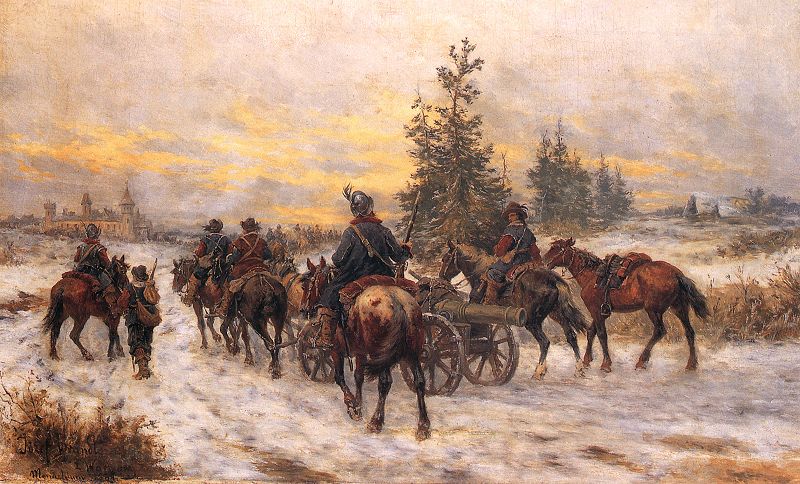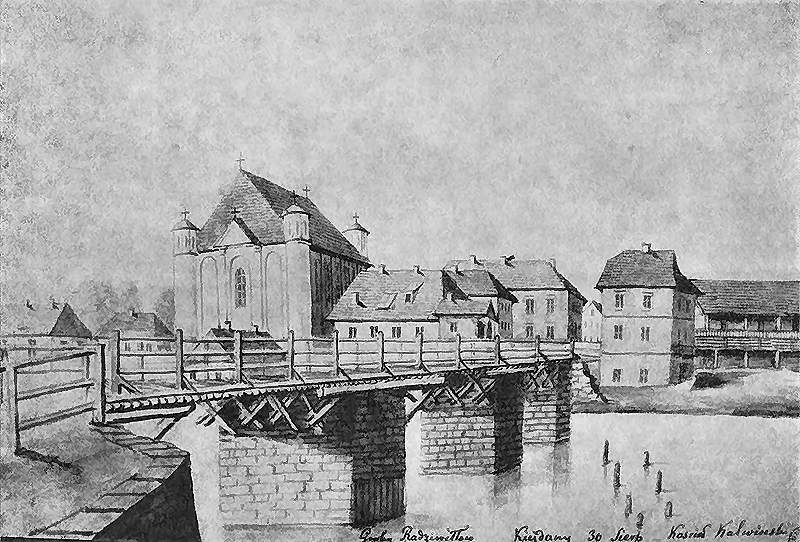|
Dotnuva
Dotnuva (formerly pl, Datnów, russian: Датновъ, Датново, Датнов, german: Dotnau) is a small town with a 2003 population of 775 in central Lithuania, 10 km northwest of Kėdainiai, in the Kėdainiai district municipality. It is located on the Dotnuvėlė River. The geographical center of Lithuania, in the village of Ruoščiai is only a few kilometers away from the town. There is a Catholic church, former Bernardine monastery, former sawmill and watermill in Dotnuva. The Dotnuva manor is in the nearby town Akademija. Dotnuva is an important center of agriculture. History left, Church of Dotnuva The first mention of the name Dotnuva was in 1372. The Dotnuva estate was known from the 16th century. In 1636 the first wooden church was built. The Brzostowski family, the owners of surrounding land and town, invited Bernardines from Vilnius and in 1701, a Bernardine monastery was established in the town. The monastery was begun to be built in 1768 and the ch ... [...More Info...] [...Related Items...] OR: [Wikipedia] [Google] [Baidu] |
Dotnuva Eldership
Dotnuva Eldership ( lt, Dotnuvos seniūnija) is a Lithuanian Elderships of Lithuania, eldership, located in a central part of Kėdainiai District Municipality. Eldership was created from the Dotnuva ''selsovet'' in 1993. Geography All the territory is in Nevėžis plain. * Rivers: Dotnuvėlė, Jaugila, Kruostas, Kačupys; * Lakes and ponds: Akademija pond, Mantviliškis pond, Urnėžiai pond, Vaidatoniai pond; * Forests: Krakės-Dotnuva forest; * Protected areas: Mociūnai forest botanical sanctuary; * Nature monuments: Ožakmenis stone. Populated places Following settlements are located in the Dontuva Eldership (as for 2011 census): *Towns: Akademija, Kėdainiai, Akademija · Dotnuva *Villages: Aušra, Kėdainiai, Aušra · Ąžuolaičiai · Beržai · Bokštai, Kėdainiai, Bokštai · Gėlainiai · Jaunakaimis · Mantviliškis · Naujaberžė · Naujieji Bakainiai · Naujieji Lažai · Noreikiai, Kėdainiai, Noreikiai · Padotnuvys · Piliamantas · Pilioniai · Puodžiai, ... [...More Info...] [...Related Items...] OR: [Wikipedia] [Google] [Baidu] |
Akademija, Kėdainiai
Akademija (formerly pl, Akademia) is a town in the Kėdainiai district municipality, in Kaunas County, central Lithuania. It lies on the left bank of the Dotnuvėlė river. According to the 2011 census, the village had a population of 752. The Lithuanian Research Centre for Agriculture and Forestry is located here. In 2018 the centre employed a total staff of 545, including 187 researchers. It had 56 doctoral students. There is Dotnuva manor and large park in Akademija. left, 245px, Lithuanian Research Centre for Agriculture and Forestry in Akademija History A school dedicated to agriculture and forestry was opened on the estate of Pyotr Stolypin in 1919. In 1922 the first plant breeding station in Lithuania was established here by Dionizas Rudzinskas. In 1923 a field trial station was also set up. An agriculture academy operated here from 1924 to 1945. In 1944 the academy's main hall was exploded by the German forces and as a result in 1946 the academy was moved to Kaunas. In ... [...More Info...] [...Related Items...] OR: [Wikipedia] [Google] [Baidu] |
Towns In Lithuania
Towns in Lithuania ( lt, miestelis) retain their historical distinctiveness even though for statistical purposes they are counted together with villages. At the time of the census in 2001, there were 103 cities, 244 towns, and some 21,000 villages in Lithuania. Since then three cities (Juodupė, Kulautuva, and Tyruliai) and two villages (Salakas and Jūrė) became towns. Therefore, during the 2011 census, there were 249 towns in Lithuania. According to Lithuanian law, a town is a compactly-built settlement with a population of 500–3,000 and at least half of the population works in economic sectors other than agriculture. [...More Info...] [...Related Items...] OR: [Wikipedia] [Google] [Baidu] |
Kėdainiai District Municipality
Kėdainiai () is one of the oldest cities in Lithuania. It is located north of Kaunas on the banks of the Nevėžis River. First mentioned in the 1372 Livonian Chronicle of Hermann de Wartberge, its population is 23,667. Its old town dates to the 17th century. The city is the administrative centre of the Kėdainiai District Municipality. The geographical centre of the Lithuanian Republic is in the nearby village of Ruoščiai, located in the eldership of Dotnuva. Names The city has been known by other names: ''Kiejdany'' in Polish, ''Keidan'' (קיידאן) in Yiddish, and ''Kedahnen'' in German. Kėdainiai other alternate forms include Kidan, Kaidan, Keidany, Keydan, Kiedamjzeÿ ("j" /e/), Kuidany, and Kidainiai. History The area was the site of several battles during "The Deluge", the 17th century war between the Polish–Lithuanian Commonwealth and Sweden. In 1655 a short-lived treaty with Sweden, the Union of Kėdainiai, was signed by two members of Radziwiłł family ... [...More Info...] [...Related Items...] OR: [Wikipedia] [Google] [Baidu] |
Ruoščiai
Ruoščiai is a small village in Kėdainiai district municipality, Lithuania. Located about 3 km from Dotnuva Dotnuva (formerly pl, Datnów, russian: Датновъ, Датново, Датнов, german: Dotnau) is a small town with a 2003 population of 775 in central Lithuania, 10 km northwest of Kėdainiai, in the Kėdainiai district municipality. ..., it had 37 residents according to the 2011 census. The settlement is known as the geographical center of Lithuania, which was calculated in 1995. Demography References Villages in Kaunas County Geographical centres {{KaunasCounty-geo-stub ... [...More Info...] [...Related Items...] OR: [Wikipedia] [Google] [Baidu] |
Dotnuvėlė
The Dotnuvėlė is a river of Kėdainiai district municipality and Radviliškis district municipality, Kaunas County, central Lithuania. It flows for 60.9 kilometres and has a basin area of 192.7 km2. It is a right tributary of the Nevėžis river. Its valley is 350–500 m wide. The current rate is 0.2-0.9 meters per second. The Dotnuvelė course goes through Skėmiai, Gudžiūnai, Mantviliškis, Akademija, Dotnuva and meets the Nevėžis river in Kėdainiai. The name ''Dotnuvėlė'' (formerly ''Dotnava'') could derive from the PIE A pie is a baked dish which is usually made of a pastry dough casing that contains a filling of various sweet or savoury ingredients. Sweet pies may be filled with fruit (as in an apple pie), nuts ( pecan pie), brown sugar ( sugar pie), swe ... root *''dā-'' ('liquid, to flow') as sa, dānu ('liquid, drop'), os, дон ('river'), av, dā-nu- ('river, current'), etc. References Rivers of Lithuania Kėdainiai District Municipa ... [...More Info...] [...Related Items...] OR: [Wikipedia] [Google] [Baidu] |
Kėdainiai
Kėdainiai () is one of the oldest List of cities in Lithuania, cities in Lithuania. It is located north of Kaunas on the banks of the Nevėžis River. First mentioned in the 1372 Livonian Chronicle of Hermann de Wartberge, its population is 23,667. Its old town dates to the 17th century. The city is the administrative centre of the Kėdainiai District Municipality. The geographical centre of the Lithuanian Republic is in the nearby village of Ruoščiai, located in the Elderships of Lithuania, eldership of Dotnuva. Names The city has been known by other names: ''Kiejdany'' in Polish language, Polish, ''Keidan'' (קיידאן) in Yiddish (language), Yiddish, and ''Kedahnen'' in German (language), German. Kėdainiai other alternate forms include Kidan, Kaidan, Keidany, Keydan, Kiedamjzeÿ ("j" /e/), Kuidany, and Kidainiai. History The area was the site of several battles during The Deluge (Polish history), "The Deluge", the 17th century war between the Polish–Lithuanian Comm ... [...More Info...] [...Related Items...] OR: [Wikipedia] [Google] [Baidu] |
Kėdainiai District Municipality
Kėdainiai () is one of the oldest cities in Lithuania. It is located north of Kaunas on the banks of the Nevėžis River. First mentioned in the 1372 Livonian Chronicle of Hermann de Wartberge, its population is 23,667. Its old town dates to the 17th century. The city is the administrative centre of the Kėdainiai District Municipality. The geographical centre of the Lithuanian Republic is in the nearby village of Ruoščiai, located in the eldership of Dotnuva. Names The city has been known by other names: ''Kiejdany'' in Polish, ''Keidan'' (קיידאן) in Yiddish, and ''Kedahnen'' in German. Kėdainiai other alternate forms include Kidan, Kaidan, Keidany, Keydan, Kiedamjzeÿ ("j" /e/), Kuidany, and Kidainiai. History The area was the site of several battles during "The Deluge", the 17th century war between the Polish–Lithuanian Commonwealth and Sweden. In 1655 a short-lived treaty with Sweden, the Union of Kėdainiai, was signed by two members of Radziwiłł family ... [...More Info...] [...Related Items...] OR: [Wikipedia] [Google] [Baidu] |
Samogitia
Samogitia or Žemaitija ( Samogitian: ''Žemaitėjė''; see below for alternative and historical names) is one of the five cultural regions of Lithuania and formerly one of the two core administrative divisions of the Grand Duchy of Lithuania alongside Lithuania proper. Žemaitija is located in northwestern Lithuania. Its largest city is Šiauliai. Žemaitija has a long and distinct cultural history, reflected in the existence of the Samogitian language. Etymology and alternative names Ruthenian sources mentioned the region as жемотьская земля, ''Žemot'skaja zemlja''; this gave rise to its Polish form, , and probably to the Middle High German . In Latin texts, the name is usually written as etc. The area has long been known to its residents and to other Lithuanians exclusively as Žemaitija (the name Samogitia is no longer in use within Lithuania and has not been used for at least two centuries); Žemaitija means "lowlands" in Lithuanian. The region is also ... [...More Info...] [...Related Items...] OR: [Wikipedia] [Google] [Baidu] |
Tarybų Lietuvos Enciklopedija
''Tarybų Lietuvos enciklopedija'' or TLE (translation: ''Encyclopedia of Soviet Lithuania'') was an encyclopedia of the Lithuanian SSR, covering topics such as archaeology, history, nature, science, cultural heritage, cities, districts, biographies of famous people and politics, but only as they relate to Lithuania. It was published in four volumes between 1985 and 1988 in Vilnius. It was derived from the 12-volume ''Lietuviškoji tarybinė enciklopedija Lithuanian encyclopedias are encyclopedias published in the Lithuanian language or encyclopedias about Lithuania and Lithuania-related topics. The first known attempt to create a Lithuanian encyclopedia was in 1883, when Jonas Jacevičius failed t ...'' but TLE did not cover general areas such as technology, biology, pharmacology, chemistry, medicine, mathematics and others. Volumes * Volume 1: A–Grūdas, 1985 * Volume 2: Grūdas–Marvelis, 1986 * Volume 3: Masaitis–Simno, 1987 * Volume 4: Simno–Žvorūnė, 1988 Reference ... [...More Info...] [...Related Items...] OR: [Wikipedia] [Google] [Baidu] |



